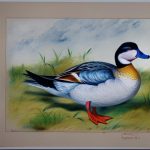German duck breeds are known for their unique characteristics and versatility. These breeds have been developed over centuries to thrive in the diverse climates and landscapes of Germany. They are prized for their ability to adapt to various environments and their excellent egg-laying and meat-producing capabilities. German duck breeds are also valued for their beautiful plumage and calm, friendly dispositions, making them popular choices for both small-scale and commercial duck farming. In this article, we will explore the history, characteristics, popular breeds, breeding and rearing practices, uses, and conservation efforts of German duck breeds.
Key Takeaways
- German duck breeds have a rich history and are known for their unique characteristics and physical traits.
- The origins of German duck breeds can be traced back to ancient times, with a focus on breeding for specific purposes.
- German duck breeds are known for their hardiness, adaptability, and excellent foraging abilities.
- Popular German duck breeds include the Pomeranian duck, Saxony duck, and Orpington duck, each with its own distinct traits and qualities.
- Conservation and preservation efforts are underway to protect and promote the unique genetic diversity of German duck breeds.
History and Origins of German Duck Breeds
The history of German duck breeds dates back to ancient times when ducks were domesticated for their eggs, meat, and feathers. Over the centuries, German breeders have selectively bred ducks to develop specific traits that are well-suited to the country’s diverse landscapes and climates. The Pomeranian duck, for example, was developed in the Pomerania region of northeastern Germany and is known for its cold-hardy nature and excellent foraging abilities. The Saxony duck, on the other hand, was developed in the Saxony region of eastern Germany and is prized for its large size and rapid growth rate. These breeding efforts have resulted in a wide variety of German duck breeds, each with its own unique characteristics and traits.
Characteristics and Physical Traits of German Duck Breeds
German duck breeds exhibit a wide range of physical traits and characteristics. They come in various colors, including white, black, blue, and silver, and often have striking patterns on their feathers. Many German duck breeds have dual-purpose capabilities, meaning they are suitable for both egg production and meat consumption. They are also known for their calm and friendly dispositions, making them ideal for small-scale farming and backyard poultry keeping. In terms of size, German duck breeds vary from medium to large, with some breeds being particularly well-known for their impressive size and weight. Additionally, these ducks are known for their strong immune systems and adaptability to different environmental conditions, making them well-suited for a variety of farming settings.
German duck breeds are also recognized for their excellent egg-laying abilities. They are known to lay a significant number of eggs throughout the year, making them valuable for both small-scale and commercial egg production. In addition to their egg-laying capabilities, German duck breeds are also prized for their flavorful and tender meat. Their large size and rapid growth rate make them an excellent choice for meat production, providing a sustainable source of high-quality protein for consumers.
Popular German Duck Breeds
Some of the most popular German duck breeds include the Pomeranian duck, Saxony duck, Orpington duck, and the Blue Swedish duck. The Pomeranian duck is known for its cold-hardy nature and excellent foraging abilities, making it well-suited to free-range farming systems. The Saxony duck is prized for its large size and rapid growth rate, making it an excellent choice for meat production. The Orpington duck is known for its calm disposition and beautiful plumage, making it a popular choice for ornamental purposes as well as egg production. The Blue Swedish duck is recognized for its striking blue plumage and excellent egg-laying capabilities, making it a valuable addition to any flock.
Breeding and Rearing German Duck Breeds
Breeding and rearing German duck breeds require careful attention to genetic diversity, health, and welfare. Breeders must select breeding stock that exhibits the desired traits and characteristics while also ensuring genetic diversity within the population. This helps to maintain the overall health and vigor of the breed. Additionally, proper nutrition, housing, and healthcare are essential for the successful rearing of German duck breeds. Providing a balanced diet, clean water, adequate shelter, and regular veterinary care are crucial for ensuring the health and well-being of the ducks.
When breeding German duck breeds, it is important to consider factors such as egg fertility, hatchability, and offspring quality. Breeders may use natural mating or artificial insemination techniques to ensure successful reproduction. Additionally, proper incubation and brooding practices are essential for raising healthy ducklings. Providing a warm and clean environment, along with appropriate feed and water, is crucial for the successful rearing of young ducks.
Uses and Purposes of German Duck Breeds

German duck breeds serve a variety of purposes, including egg production, meat consumption, ornamental purposes, pest control, and conservation efforts. Their excellent egg-laying capabilities make them valuable for small-scale and commercial egg production. Their flavorful and tender meat also makes them an excellent choice for meat production. Additionally, their beautiful plumage and calm dispositions make them popular choices for ornamental purposes in backyard flocks and farm settings.
German duck breeds are also known for their excellent foraging abilities, making them effective at pest control in agricultural settings. They can help control insect populations in fields and gardens while also providing fertilizer through their droppings. Furthermore, German duck breeds play a crucial role in conservation efforts to preserve rare and endangered breeds. By raising and breeding these ducks, farmers and breeders contribute to the conservation of genetic diversity within the poultry industry.
Conservation and Preservation Efforts for German Duck Breeds
Conservation efforts for German duck breeds are essential for preserving genetic diversity and maintaining healthy populations of these valuable birds. Organizations such as the German Poultry Association work to promote the conservation of rare and endangered duck breeds through education, breeding programs, and advocacy. These efforts help raise awareness about the importance of preserving genetic diversity within poultry populations.
Conservation breeding programs focus on maintaining healthy populations of rare German duck breeds by carefully managing breeding stock, promoting genetic diversity, and preventing inbreeding. By maintaining healthy populations of these ducks, conservation efforts help ensure that valuable traits and characteristics are preserved for future generations. Additionally, conservation programs work to promote the use of rare German duck breeds in sustainable farming systems, helping to maintain their cultural significance and economic value.
In conclusion, German duck breeds are valued for their unique characteristics, versatility, and contributions to egg production, meat consumption, ornamental purposes, pest control, and conservation efforts. Through careful breeding and rearing practices, these ducks continue to play an important role in sustainable agriculture while contributing to the preservation of genetic diversity within poultry populations. Conservation efforts are crucial for ensuring the long-term viability of these valuable breeds and maintaining their cultural significance within the poultry industry.
If you’re interested in learning more about German duck breeds, you might also want to check out an article on Poultry Wizard about converting a shed to a chicken coop. This article provides valuable insights into creating a suitable environment for poultry, which can be helpful when considering the specific needs of different duck breeds. You can find the article here.
FAQs
What are some common German duck breeds?
Some common German duck breeds include the Pomeranian duck, the Saxony duck, the Orpington duck, and the Pekin duck.
What are the characteristics of German duck breeds?
German duck breeds are known for their hardiness, good egg-laying abilities, and calm temperament. They come in a variety of colors and patterns, and are often raised for both meat and egg production.
What is the history of German duck breeds?
German duck breeds have been developed over many years through selective breeding for specific traits such as egg production, meat quality, and adaptability to various climates. They have become popular not only in Germany, but also in other parts of the world.
What are some considerations for raising German duck breeds?
When raising German duck breeds, it is important to provide them with a suitable environment that includes access to water for swimming and foraging. They also require proper nutrition, protection from predators, and regular health care.
Are German duck breeds suitable for small-scale farming?
Yes, German duck breeds are often well-suited for small-scale farming operations due to their adaptability, good egg-laying abilities, and relatively calm temperament. They can thrive in a variety of environments and are often a popular choice for backyard poultry keepers.
Meet Walter, the feathered-friend fanatic of Florida! Nestled in the sunshine state, Walter struts through life with his feathered companions, clucking his way to happiness. With a coop that’s fancier than a five-star hotel, he’s the Don Juan of the chicken world. When he’s not teaching his hens to do the cha-cha, you’ll find him in a heated debate with his prized rooster, Sir Clucks-a-Lot. Walter’s poultry passion is no yolk; he’s the sunny-side-up guy you never knew you needed in your flock of friends!







